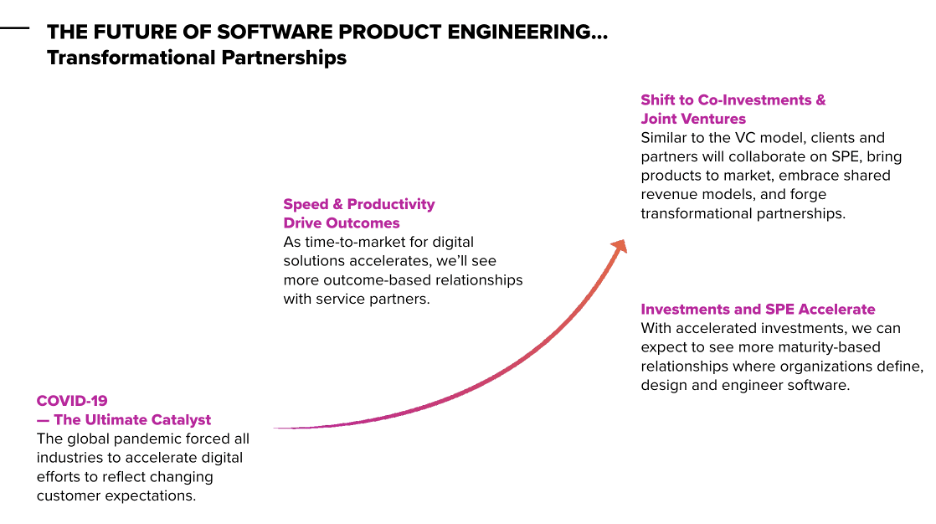Cognizant Softvision share their views on transformational partnerships and the rise of outcome-based relationships in the first of a two-part article series.
The global pandemic has resulted in a dramatic increase in product engineering investments, as brands and enterprises look to quickly transform legacy systems and technology. Companies also are designing and building new software and products to engage directly with consumers and employees who were in their homes, digitally, and most importantly, on their terms.
Developing an exciting, engaging experience helps achieve meaningful outcomes for the user, which results in even more engagement. Ultimately, as the business realizes its ROI, it will reinvest in a cycle where the user gets a better product, and the business cements its competitive differentiation.
For example, agile-based product development is becoming the expected standard, but that is more difficult than it sounds for large enterprises. We consistently speak with CIOs of Fortune 500 companies who are asking for help in shifting towards a “product-centric engineering” model. They struggle with project-based budgets and teams with a fixed scope and fixed timeline for delivery. Teams are built and then disbanded when the fixed scope is delivered (or fails to be completed). This so-called “waterfall” mindset often comes from top executives.
What enterprises need instead is to shift towards true product engineering. This requires product-based budgets. Teams should be custom built based on the product they are defining and engineering. These teams should have a product lead, and they should be in place indefinitely, with an ongoing roadmap and a consistent connection to the end user. They should leverage agile development, which will ensure an active backlog of priorities that can be changed or prioritized with each “sprint.” The product/software can be pushed to production at the end of any given sprint.
Products should be measured based on outcomes that equate to business success. That could include increased revenue, customer satisfaction, user acquisition, or reduction in time to complete a task. Supposedly agile projects often cite technical metrics like “story points per sprint” or other abstractions. Although those might be adequate to measure team productivity of adherence to standards, they don’t connect each team with the business goals that would make a product successful. Thus, accountability is lost, and products fail.
What works is an operating model in which alignment with the business is empowered. Team members must be supported by expert communities and the business should not only fund, but be hands-on representing users. The roadmap should be defined in tandem with design and engineering staff. This way, every team will be held accountable for product outcomes. This requires buy-in from senior executives. More often, they instead start asking for a specific scope by a certain date for a fixed budget. But that inevitably throws the whole model out the window and forces teams back to a waterfall mindset.

More Mature Relationships with Service Companies
All this matters because brands and companies need software products and digital-first businesses to engage with customers and enable employees. This not only generates meaningful, profitable growth, but also builds a valuable reputation for innovation.
But in the past, relationships with market leading service companies have been defined by traditional time and materials models. Now, companies must ask partners to do more, which means embracing a performance-based, outcome-driven model. Engineering services partners will now be held accountable for delivering software that drives business success. This shift to performance-based models represents the future of the services industry, but it’s due in large part to the changing mindset of today’s consumer. Their expectations for digitally-sophisticated products and services have gone up.
Here’s an example: for a large multinational manufacturer of beauty and skincare products, Cognizant Softvision teams architected and built an ecommerce platform to support all the company’s brands across 55 countries and 35 languages. Our dedicated cross-functional teams are not just measured on speed and quality (which you’d expect in an engineering environment), but also on the impact on the customer’s revenue, size of e-commerce shopping basket, and conversion rates. These elements lead to business success.
For a major health insurance company, we are designing and building a “new member” application and enrolment experience. Today, when a potential member applies and provides their health history and information, it takes 11 days from the moment they press “submit” to evaluate the application and determine if they can be onboarded. However, Cognizant found that about 80% of this time could be eliminated for the majority of applicants. For that project, we’ve defined relevant business outcomes including average days to decision, Customer Satisfaction Scores (CSAT), and the money the insurer loses of an applicant goes elsewhere.
A New Model of Co-Investment: Transformational Partnerships
The second major industry shift will be towards an entirely new “S curve”. That means the ability to climb and shift the curve will be what separates high performers from those that can’t translate brief success with one business into a string of business successes. “S curve” indicates a pattern of revenue growth. A successful business starts small with few customers, grows rapidly as demand for the new offering swells, and then eventually peaks and levels off as the market matures. If a market or industry shifts to a new S curve and leading businesses don’t see the shift and make the jump themselves, they will ultimately die, because the market size of the original “S” will eventually trail off.
The graphic below shows our prediction for how the product engineering market will move towards more ‘transformational partnerships’, in which clients and product engineering providers embark on joint ventures or “co-investment” scenarios. That way, both parties will invest and share in the upside.

Three key predictions support the market shifts noted above in a recent McKinsey article, From surviving to thriving: Reimagining the post-COVID-19 return. First, COVID-19 will cause industries to refocus digital efforts to reflect changing customer expectations. Consumers are fully distributed and must be able to engage remotely. If organizations don’t build the muscle to be able to define, design and engineer software, customers will find other alternatives.
Second, McKinsey predicts we will see an increase in the speed and productivity of digital solutions. As we explained above, enterprises that seek to do this at speed will expect an outcome-based relationship with their service partners. This is natural if the client is paying for performance. As organizations and internal teams mature in their ability to deliver with confidence and velocity to hit business goals, the costs associated with the team grow. So, there will be a natural market evolution towards Transformational Partnerships, which few companies are yet positioned to take advantage of.

In the past, relationships with market leading service companies have been defined by traditional time and materials models. Now, companies must ask partners to do more, which means embracing a performance-based, outcome-driven model.
Three key predictions support the market shifts noted above in a recent McKinsey article, From surviving to thriving: Reimagining the post-COVID-19 return. First, COVID-19 will cause industries to refocus digital efforts to reflect changing customer expectations. Consumers are fully distributed and must be able to engage remotely. If organizations don’t build the muscle to be able to define, design and engineer software, customers will find other alternatives.
Second, McKinsey predicts we will see an increase in the speed and productivity of digital solutions. As we explained above, enterprises that seek to do this at speed will expect an outcome-based relationship with their service partners. This is natural if the client is paying for performance. As organizations and internal teams mature in their ability to deliver with confidence and velocity to hit business goals, the costs associated with the team grow. So, there will be a natural market evolution towards Transformational Partnerships, which few companies are yet positioned to take advantage of.
ABOUT OUR GUEST WRITERS
Andres Angelani
Chief Executive Officer, Cognizant Softvision
Andres has extensive experience developing large-scale technology businesses. He is a proven leader in effectively deploying technology and business process strategies, leveraging his proficiency in Digital Strategy, Agility and Team Development, Game Development and Enterprise Software Architectures.
Bret Cunningham
Commercial GM, Product Engineering Practice, Cognizant Softvision
Leads Cognizant Softvision’s Innovations and Labs program. Bret oversees go-to-market strategy working across industries to bring unique domain and product engineering capabilities to meet client’s needs. As head of Strategy & Solutions, Bret runs the global digital product teams and brings Cognizant Softvision’s best creative, industry and technical domain leaders together to define, design, and build digital products that enable client’s businesses.












